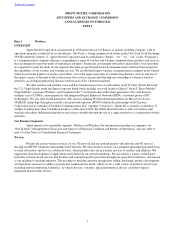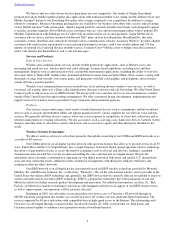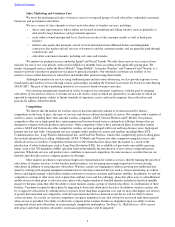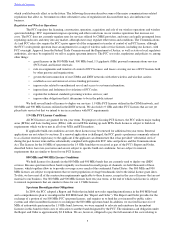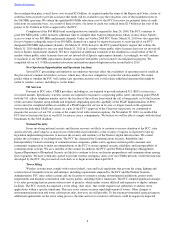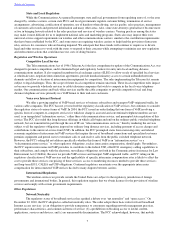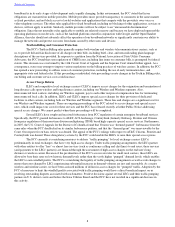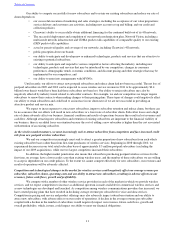Sprint - Nextel 2010 Annual Report Download - page 13
Download and view the complete annual report
Please find page 13 of the 2010 Sprint - Nextel annual report below. You can navigate through the pages in the report by either clicking on the pages listed below, or by using the keyword search tool below to find specific information within the annual report.
Our ability to compete successfully for new subscribers and to retain our existing subscribers and reduce our rate of
churn depends on:
• our successful execution of marketing and sales strategies, including the acceptance of our value proposition;
service delivery and customer care activities, including new account set up and billing; and our credit and
collection policies;
• Clearwire's ability to successfully obtain additional financing for the continued build-out of its 4G network;
• The successful deployment and completion of our network modernization plan, Network Vision, including a
multi-mode network infrastructure and CDMA push-to-talk capabilities of comparable quality to our existing
iDEN push-to-talk capabilities;
• actual or perceived quality and coverage of our networks, including Clearwire's 4G network;
• public perception about our brands;
• our ability to anticipate and develop new or enhanced technologies, products and services that are attractive to
existing or potential subscribers;
• our ability to anticipate and respond to various competitive factors affecting the industry, including new
technologies, products and services that may be introduced by our competitors, changes in consumer
preferences, demographic trends, economic conditions, and discount pricing and other strategies that may be
implemented by our competitors; and
• our ability to enter into arrangements with MVNOs.
Until recently, our efforts to attract new postpaid subscribers and reduce churn had not been successful. The net loss of
postpaid subscribers in 2009 and 2010 can be expected to cause wireless service revenue in 2011 to be approximately $2.4
billion lower than it would have been had those subscribers not been lost. Our ability to retain subscribers may also be
negatively affected by industry trends related to subscriber contracts. For example, we and our competitors no longer require
subscribers to renew their contracts when making changes to their pricing plans. These types of changes could negatively affect
our ability to retain subscribers and could lead to an increase in our churn rates if we are not successful in providing an
attractive product and service mix.
We expect to incur expenses to attract new subscribers, improve subscriber retention and reduce churn, but there can
be no assurance that our efforts will result in new subscribers or a lower rate of subscriber churn. Subscriber losses and a high
rate of churn adversely affect our business, financial condition and results of operations because they result in lost revenues and
cash flow. Although attracting new subscribers and retention of existing subscribers are important to the financial viability of
our business, there is an added focus on retention because the cost of adding a new subscriber is higher than the cost associated
with retention of an existing subscriber.
As the wireless market matures, we must increasingly seek to attract subscribers from competitors and face increased credit
risk from new postpaid wireless subscribers.
We and our competitors increasingly must seek to attract a greater proportion of new subscribers from each other's
existing subscriber bases rather than from first-time purchasers of wireless services. Beginning in 2008 through 2010, we
experienced decreases in our total retail subscriber base of approximately 8.5 million postpaid subscribers (excluding the
impact of our 2009 acquisitions), while our two largest competitors increased their subscribers.
In addition, the higher market penetration also means that subscribers purchasing postpaid wireless services for the
first time, on average, have a lower credit score than existing wireless users, and the number of these subscribers we are willing
to accept is dependent on our credit policies. To the extent we cannot compete effectively for new subscribers, our revenues and
results of operations will be adversely affected.
Competition and technological changes in the market for wireless services could negatively affect our average revenue per
subscriber, subscriber churn, operating costs and our ability to attract new subscribers, resulting in adverse effects on our
revenues, future cash flows, growth and profitability.
We compete with a number of other wireless service providers in each of the markets in which we provide wireless
services, and we expect competition to increase as additional spectrum is made available for commercial wireless services and
as new technologies are developed and launched. As competition among wireless communications providers has increased, we
have created pricing plans that have resulted in declining average revenue per subscriber for voice and data services.
Competition in pricing and service and product offerings may also adversely impact subscriber retention and our ability to
attract new subscribers, with adverse effects on our results of operations. A decline in the average revenue per subscriber
coupled with a decline in the number of subscribers would negatively impact our revenues, future cash flows, growth and
overall profitability, which, in turn, could impact our ability to meet our financial obligations.
Table of Contents
11


